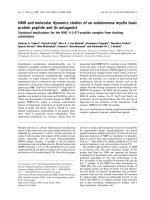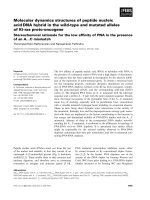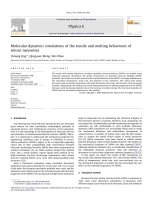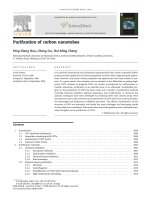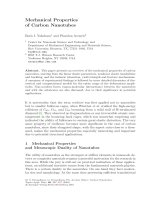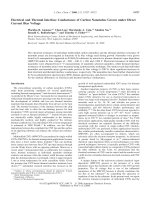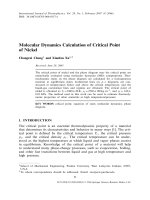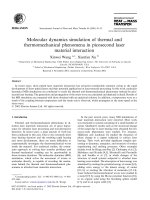Comprehensive molecular dynamics simulations of carbon nanotubes under axial force or torsion vibration and new continuum models
Bạn đang xem bản rút gọn của tài liệu. Xem và tải ngay bản đầy đủ của tài liệu tại đây (11.78 MB, 246 trang )
COMPREHENSIVE MOLECULAR DYNAMICS
SIMULATIONS OF CARBON NANOTUBES UNDER
AXIAL FORCE OR TORSION OR VIBRATION
AND NEW CONTINUUM MODELS
AMAR NATH ROY CHOWDHURY
(B.Eng. (Hons.), Jadavpur University.
M.Tech., Indian Institute of Technology Bombay, India)
A THESIS SUBMITTED
FOR THE DEGREE OF DOCTOR OF PHILOSOPHY
DEPARTMENT OF CIVIL AND ENVIRONMENTAL ENGINEERING
NATIONAL UNIVERSITY OF SINGAPORE
2014
iii
DECLARATION
I hereby declare that the thesis is my original work and it has been written by me in its
entirety.
I have duly acknowledged all the sources of information which have been used in the
thesis.
This thesis has also not been submitted for any degree in any university previously.
______________________________________
Amar Nath Roy Chowdhury
December 2014
v
ACKNOWLEDGMENTS
I would like to express my sincere gratitude towards Professor Wang Chien Ming for
giving me the opportunity to pursue a doctoral research in the Department of Civil
and Environmental Engineering at National University of Singapore. Occasionally,
during my PhD study, I felt disappointed and demotivated by getting stuck on
research problems, but thanks to Prof Wang’s valuable guidance, I was able to regain
hope to carry out the research work. I would also like to thank Dr. Adrian Koh of the
Department of Mechanical Engineering for helping me to enrich my analytical and
critical thinking capabilities. I want to express special thanks to both of them for
listening to all of my ideas, and for mentoring me to complete the PhD research.
Because of Prof. Wang and Dr. Koh’s patience and expert advices, I am able to sculpt
my research work in the form of this thesis within the desired period of time.
In the first semester, I was also lucky to get the opportunity to interact with Dr.
Prakash Thamburaja who was a former faculty the Department of Mechanical
Engineering at NUS. He helped me to understand some advanced concepts of
continuum mechanics that were and are useful for my research. Thanks to Dr.
Yingyan Zhang of University of Western Sydney for helping me to learn molecular
dynamics techniques using LAMMPS. Also, I wish to acknowledge Dr. Zhi Yung
Tay of University of Edinburgh for introducing me to ABAQUS.
Special thanks go to NUS-HPC for the terrific computational resources and to
NUS library for the vast source of literature, without them I would have not been able
to finish the work within four years.
vi
I am deeply thankful to my uncle Deb Kumar Mitra, my father Biswanath Roy
Chowdhury, two of my aunts Lina Mitra and Bharati Sengupta, and my mother Mina
Roy Chowdhury for being so awesome, caring and supporting.
My special thanks also go to three of my very close childhood friends Sandip Saha,
Sandip Dutta and Sumit Mukherjee who were always with me to overcome hard times
in the last four years, thereby assisting me to progress in my academic career. I also
want to thank my friends and four-years-roommates Nirmalya Bag, and Shubham
Duttagupta for making the PhD life fun-filled.
Last but not the least I want to dedicate this thesis to the loving memories of my
uncle Ashoke Sengupta whose feats and success stories motivated me to pursue
scientific career and also to my beloved aunt Shila Mitra.
vii
CONTENTS
Declaration iii
Acknowledgments v
Contents vii
Extended summary xiii
List of tables xvii
List of figures xix
List of symbols and acronyms xxvii
Chapter 1 Introduction 1
1.1 Properties and applications of carbon nanotubes 1
1.1.1 Geometric properties of carbon nanotubes 1
1.1.2 Mechanical properties of CNT and its characterization 3
1.1.3 Applications of CNT 12
1.2 Computational models to study mechanics of carbon nanotubes 15
1.2.1 Atomistic models of carbon nanotubes 16
1.2.2 Continuum models of CNT 19
1.3 Literature review 22
1.3.1 Atomistic simulations of compression and torsional buckling of CNT . 22
1.3.2 Atomistic and continuum models for CNT under tension 31
1.3.3 Vibration frequencies of CNT using atomistic calculations 33
1.4 Objectives of thesis 35
viii
1.5 Layout of thesis 37
Chapter 2 Details on MD simulation of CNT 39
2.1 Mathematical construct of CNT 39
2.2 Description of simulation steps 41
2.2.1 Interatomic potential 43
2.2.2 Energy relaxation 49
2.2.3 Integration time-step 52
2.2.4 Incremental displacement or displacement rate 53
2.2.5 Relaxation time T
s
54
2.2.6 Thermostat 59
2.2.7 Barostat 62
2.2.8 Brief description of MD simulation steps with NVT ensemble 63
2.3 Comparison of MD simulations with NPT and NVT ensemble 63
2.4 Summary and key findings 65
Chapter 3 MD simulations of CNT under compression 67
3.1 Load deformation behaviour of CNT under compression 67
3.1.1 Displacement rate for MD simulation 67
3.1.2 Stress-strain response 69
3.2 Buckling of CNT under compression 72
3.2.1 Definition buckling 73
3.2.2 Compressive buckling results for non-chiral SWCNTs 75
ix
3.2.3 Effect of θ on buckling properties 78
3.2.4 Effect of wall numbers on buckling characteristics of CNT 81
3.3 Summary and Conclusions 83
Chapter 4 MD simulations of CNT under torsion 85
4.1 Torque-twist response of SWCNT 85
4.1.1 Twisting rate for MD simulation 85
4.1.2 Shear stress-shear strain response 87
4.2 Torsional buckling of CNT 96
4.2.1 Definition of torsional buckling 96
4.2.2 Torsional buckling results for non-chiral SWCNTs 98
4.2.3 Effect of θ and D on torsional buckling of SWCNT 100
4.2.4 Effect of wall numbers on torsional buckling of CNT 102
4.3 Summary and Conclusions 103
Chapter 5 Thick shell model for CNT 105
5.1 Description of cylindrical shell theory 105
5.2 Compressive buckling of CNT 108
5.2.1 Calibration of E of SWCNTs 109
5.2.2 Inter-tube van der Waals interaction in MWCNT 112
5.2.3 Finite element model for buckling analysis of CNTs 113
5.2.4 Compressive buckling of CNT: comparison of thick shell and MD
results 115
5.3 Torsional buckling of CNT 125
x
5.3.1 Thick shell results for torsional buckling of armchair SWCNTs 126
5.3.2 Torsional buckling of chiral SWCNTs 130
5.3.3 Torsional buckling of armchair and zigzag MWCNTs 135
5.4 Summary and Conclusions 139
Chapter 6 Continuum models for CNT under tension 141
6.1 Introduction 141
6.2 Atomistic simulations 143
6.3 Membrane-shell model of SWCNT 147
6.3.1 Kinematics of axial deformation 148
6.3.2 Constitutive relation 149
6.3.3 Calibration of material parameters 152
6.3.4 Advantages and disadvantages of membrane-shell model 155
6.4 Hyper-elastic continuum model of CNT with softening 155
6.4.1 Softening hyper-elasticity 156
6.4.2 Thermal effect 161
6.4.3 Effect of hydrostatic pressure 163
6.4.4 Advantages and disadvantages of hyper-elastic continuum model 167
6.5 Summary and Conclusions 168
Chapter 7 Modal analysis of CNT 171
7.1 Calculation of vibration frequency from MD simulation 171
7.2 Operational modal analysis using TDD 172
xi
7.2.1 Theoretical background 172
7.2.2 Steps in OMA using TDD and its implementation 173
7.3 Modal analysis of CNT 175
7.3.1 Comparison of two different approaches for calculating vibration
frequencies 175
7.3.2 Vibration modes of SWCNT 177
7.3.3 Thick shell model 183
7.4 Summary and Conclusions 186
Chapter 8 Conclusions and Future Studies 187
8.1 Overall Summary and Conclusions 187
8.2 Future Studies 192
References 197
List of author’s publications 217
xiii
EXTENDED SUMMARY
The main objective of this thesis is to obtain continuum models suitable to analyze
mechanics of carbon nanotube (CNT) under uni-axial deformation, torsion, and
vibration. In general, continuum models of CNT are calibrated from atomistic
simulations. Existing molecular dynamics (MD) simulation results for CNT under
uni-axial deformation, torsion, and vibration are not comprehensive. Moreover, in
many cases discrepancies are observed in MD simulation results reported by different
researchers. For that purpose, extensive classical MD simulations are performed to
generate accurate benchmark results for CNT under uni-axial deformation, torsion
and vibration. The MD simulations are performed using AIREBO potential. Radial
breathing frequencies of SWCNT are calculated from MD simulations; we
demonstrate that these frequencies are very close to experimental results. We will also
show that the nominal stress (t
Z
) versus stretch (λ
Z
) response of SWCNT under tension
and compression predicted by MD simulation are close to the first principle
calculation results. Thus, we establish the suitability of AIREBO potential for CNT.
Our MD simulations reveal that prior to buckling the t
Z
versus nominal strain (
Z
)
response of SWCNT is nonlinear and it depends on chiral angle (θ) of SWCNT.
Interestingly, the t
Z
-
Z
response of MWCNT is not affected by inter-tube van der
Waals interaction. However, the buckling load (P
cr
) and buckling strain (
cr
) of CNT
depend on length (L), diameter (D), wall number, and θ of SWCNT. We show that the
P
cr
and
cr
of zigzag SWCNT are greater than the P
cr
or
cr
of its armchair counterpart.
For the first time, it is found that the effect of θ on P
cr
and
cr
diminishes as the aspect
ratio (L/D) increases. Beyond L/D of 15.0, the P
cr
and
cr
values of SWCNT are
almost unaffected by θ.
xiv
We demonstrate that the shear stress (τ) versus shear strain (
) of SWCNT depends
on D, L, and θ. In case of chiral SWCNT, the τ-
response also depends on twist
direction because the carbon-carbon bonds are asymmetrically arranged along the
length and perimeter of SWCNT, and the force deformation relation of carbon-carbon
bond is different under compression and tension. The MD simulation results reveal
that the shear modulus (G) of non-chiral SWCNT depends on D. As D increases, the
G of non-chiral SWCNT becomes almost equal to 240 GPa. The G of chiral SWCNT
also depends on twist direction. SWCNT with chiral angle 15.5
o
has the highest G
under clockwise torsion, but G of the same SWCNT is the lowest under anti-
clockwise torsion. Occurrence of torsional buckling is indicated by the degradation of
the slope of (torque) M
Z
versus (end rotation)
curve. The critical buckling torque
(M
cr
) and critical buckling end-rotation (
cr
) of CNT depend on L, D, wall number,
and θ of non-chiral SWCNTs. For chiral CNTs, M
cr
and
cr
depend on twist direction
also. M
cr
and
cr
of chiral SWCNT under anti-clockwise torsion, is greater than the
M
cr
and
cr
of chiral SWCNT under clockwise torsion. Although in case of MWCNT
the τ-
relation is not affected by number of walls, but the torsional buckling
characteristics depend on wall number. For MWCNT, M
cr
increases with the increase
in wall number and
cr
decreases with the increase in wall number.
We use the thick shell theory to analyze the buckling of CNT as an alternative to
MD simulation. Since SWCNT manifests a nonlinear response under compression the
E is calculated from the secant modulus of compressive t
Z
-
Z
curve evaluated at the
occurrence of buckling. Assuming Poisson’s ratio
= 0.19 and the shell thickness h =
0.066 nm, an empirical equation for the Young’s modulus (E) of chiral SWCNT is
established. Thick shell theory with proposed E gives P
cr
values of CNT close to MD
xv
simulation results. The
cr
of CNT is derived from the nonlinear t
Z
-
Z
derived from
MD simulation results. It will be demonstrated that the
cr
values predicted by thick
shell theory are very close to MD simulation results.
Torsional buckling of CNT also depends on twist direction. So, E is modified to
account for twist direction. For non-chiral SWCNTs, the shell model is able to predict
M
cr
and
cr
of SWCNT and MWCNT close to MD simulation results. However, the
cr
values of chiral SWCNTs have 20 % deviation from the
cr
values predicted by
MD simulations. This is a drawback of the thick shell model.
CNT under tension displays nonlinear elastic t
Z
-λ
Z
response with stress-softening.
In Chapter 6, two constitutive models are proposed to analyze nonlinear tensile
response of CNT prior to fracture. To ensure minimum loss of accuracy, the t
Z
-λ
Z
response predicted by MD simulations are compared with first principle calculation
results. From the comparison studies, it is demonstrated that the t
Z
-λ
Z
response
predicted by MD simulations is close to first principle calculation results up to a strain
level of 22% for armchair and up-to a strain level of 16% for zigzag tube. It will be
also demonstrated that the t
Z
-λ
Z
response of SWCNT depends on θ but it is
independent of D and L. The first continuum approach is named as membrane-shell
model which uses a nonlinear constitutive relation. The nonlinear constitutive relation
of the membrane-shell is calibrated using MD simulation results. We establish that the
membrane shell model can closely mimic the t
Z
-λ
Z
curve of chiral SWCNT obtained
from MD simulation results. Another continuum model is derived based on the
concept of softening hyper-elasticity proposed by Volokh (2007). This continuum
model is extended to incorporate thermal effect on mechanical response of SWCNT.
We demonstrate that the t
Z
-λ
Z
response of SWCNT predicted by this temperature-
xvi
dependent continuum model is also in excellent agreement with MD simulation
results.
In Chapter 7, the time domain decomposition technique is employed to calculate
the vibration frequencies and mode shapes of SWCNTs from MD simulation
trajectories. Comparing the vibration frequencies of various chiral SWCNTs, we find
that the vibration frequencies of SWCNT are independent of θ, but similar to a thick
cylindrical shell, the vibration frequencies depend on D and L of SWCNT. Thick shell
theory is used to calculate vibration frequencies. We observe that the vibration
frequencies calculated using the thick shell theory are very close to MD simulation
results.
xvii
LIST OF TABLES
Table 1.1. E of CNT from various experiments 5
Table 1.2 Mechanical properties of various fiber materials 11
Table 1.3: Electrical and thermal properties of CNT 12
Table 1.4: Summary of SWCNT buckling under torsion 29
Table 1.5: Summary of DWCNT buckling under torsion 31
Table 2.1: Parameters for original REBO interaction for carbon-carbon bond 45
Table 2.2: Influence of T
s
on critical buckling load 55
Table 3.1: MD buckling results for armchair SWCNTs under axial load 75
Table 3.2: MD buckling results for zigzag SWCNTs under axial load 76
Table 3.3: Effect of chiral indices on MD buckling results for SWCNTs 78
Table 3.4: MD buckling results for armchair DWCNTs with L/D
i
≤ 10 under axial
load 81
Table 3.5: MD buckling results for zigzag and chiral DWCNTs with L/D
i
≤ 10 under
axial load 82
Table 4.1: MD buckling results for armchair SWCNTs with L/D ≤ 10 under torsion98
Table 4.2: MD buckling results for zigzag SWCNTs with L/D ≤ 10 under torsion 99
Table 4.3: MD buckling results for armchair DWCNTs with L/D
i
≤ 10 under torsion
102
Table 4.4: MD buckling results for zigzag DWCNTs with L/D
i
≤ 10 under torsion
102
Table 5.1: Parameters c
i
(θ) for shell model 119
Table 5.2: The shell results versus MD simulation results for TWCNT under
compression 124
Table 5.3: Shell results versus MD simulation results for TWCNT under torsion 136
Table 6.1: Parameters of atomistic-continuum shell and structural mechanics models
proposed by different researchers 141
Table 6.2: Comparison of t
cr
and λ
cr
values of SWCNT calculated using MD and first
principle calculations 145
Table 6.3: Parameters of SWCNT membrane-shell model (h = 1) 152
xviii
Table 6.4: E of SWCNT from experiment or first principle calculation 153
Table 7.1: Comparison of vibration frequencies of chiral SWCNTs 183
Table 7.2: Mass densities of various SWCNTs 184
Table 7.3: Comparison of vibration frequencies of SWCNT using of thick shell and
MD 185
xix
LIST OF FIGURES
Figure 1.1. (a) Translational vector T
h
and chiral vector (Dresselhaus et al. 1995) C
h
(b) Three types of carbon nanotubes. 2
Figure 1.2. High-resolution TEM image of bent nanotube (radius of curvature 400
nm), showing characteristic wavelike distortion adopted from Poncharal et al. (1999).
6
Figure 1.3. TEM micrographs of buckled long and slender MWCNT adopted from
Lourie et al. (1998). 6
Figure 1.4. Load deformation curve of CNT under cyclic compression (Yap et al.
2007). 7
Figure 1.5. (a) Tensile testing of MWCNT. Black arrow represent fixed end and white
arrow represents moving direction. (b) MWCNT after breaking (Demczyk et al.
2002). 8
Figure 1.6. Elongation of SWCNT under tensile deformation Huang et al. (2006b) 9
Figure 1.7: CNT based nano-probes for imaging material surface using tapping-mode
microscopy (a) CNT probe, (b) voltage displacement curve (c) different stages of
tapping-mode microscopy and possibility of buckling of CNT tip (Wilson and
Macpherson 2009). 14
Figure 1.8: CNT pressure sensor (Stampfer et al. 2006c). 15
Figure 1.9: CNT-based torsional NEMS (Cohen-Karni et al. 2006). 15
Figure 1.10: Discrepancies in reported
cr
of SWCNT(5,5) 27
Figure 1.11: Discrepancies in reported
cr
of DWCNT((5,5),(10,10)). 28
Figure 2.1: Hexagonal graphene lattice and CNT unit cell. 40
Figure 2.2: Molecular dynamics simulation set-up for CNT under uniaxial
deformation/torsion. 41
Figure 2.3: Molecular dynamics simulation set-up for CNT under uniaxial
deformation/torsion using NPT ensemble (there are total 26 periodic images in 3
dimension but only 2 are shown for simplicity). 43
Figure 2.4: AIREBO (a) potential energy as function of r
ij
(b) interatomic force as
function of r
ij
. 46
Figure 2.5: (a) Dihedral bond rotation, (b) Typical neighborhood of an atom with id 1
in pristine carbon nanotube. 47
Figure 2.6: Comparison of radial breathing mode frequencies ω
RBM
. 49
Figure 2.7: Effect energy relaxation on P versus Δ plot of CNT 51
xx
Figure 2.8: A sample total potential energy versus simulation time for 2.8 nm long
SWCNT(20,20) under tension 55
Figure 2.9: Total potential energy versus simulation time for 12.0 nm long
SWCNT(20,20) under compression 56
Figure 2.10: Total potential energy versus simulation time for 12.0 nm long
SWCNT(20,20) under tension 56
Figure 2.11: Total potential energy versus simulation time for 12.0 nm long
SWCNT(20,20) under torsion 57
Figure 2.12: Total potential energy versus simulation time for 12.0 nm long
SWCNT(26,0) under compression 57
Figure 2.13: Total potential energy versus simulation time for 13.6 nm long
DWCNT((10,10),(15,15)) under compression 58
Figure 2.14: Total potential energy versus simulation time for 13.6 nm long
DWCNT((10,10),(15,15)) under tension 58
Figure 2.15: Total potential energy versus simulation time for 4.0 nm long
TWCNT((10,10),(15,15),(20,20)) under compression 59
Figure 2.16: Effect of thermostat on thermal equilibrium at (a) 1 K (b) 300 K for
Berendsen thermostat τ
T
= 100 ps. For Nosé-Hoover thermostat τ
T
= 1 ps 62
Figure 2.17: t
Z
versus λ
Z
curves for (a) SWCNT under tension (b) SWCNT under
compression. 64
Figure 3.1: Effect of large incremental displacement on load deformation plot (case
study was performed on 6 nm DWCNT((5,5),(10,10)) 69
Figure 3.2: t
Z
-ε
Z
curves of zigzag (θ = 0
o
) and armchair (θ = 30
o
) SWCNTs. 70
Figure 3.3: Elastic response of SWCNT under cyclic uni-axial compression. 71
Figure 3.4: t
Z
-ε
Z
curve of MWCNT 72
Figure 3.5: Typical P versus Δ plot for CNT with L/D 10 under compression (b)
deformed shape of CNT prior to buckling (c) Buckled mode shape of CNT. 73
Figure 3.6a: Typical P versus Δ plot for CNT with L/D 10 under compression. 74
Figure 3.7: Transition of buckling mode shapes from shell-type to beam-type for
SWCNT(5,5) from three different perspectives 76
Figure 3.8: Comparison of ε
cr
for SWCNT(5,5) obtained using AIREBO potential
with existing results. 77
Figure 3.9: Comparison of ε
cr
for DWCNT((5,5),(10,10)) obtained using AIREBO
potential with existing results. 77
xxi
Figure 3.10: Effect of θ on P
cr
calculated using MD simulation with AIREBO
potential (filled circle ), MD simulation by Zhang et al. (2006) (inverted triangle). . 79
Figure 3.11: Effect of θ on ε
cr
calculated using MD simulation with AIREBO
potential (filled circle ), MD simulation by Zhang et al. (2006) (inverted triangle). . 80
Figure 3.12: Effect of L/D on P
cr
and ε
cr
values of armchair SWCNT (solid triangle),
chiral SWCNT (open circle), and zigzag SWCNT (square with cross). 80
Figure 3.13: Buckling mode shapes of DWCNT((5,5),(10,10)) from three different
perspectives. 82
Figure 3.14: Comparison of
cr
strains for DWCNT((5,5),(10,10)) obtained using
AIREBO potential with existing results. 83
Figure 4.1: Effect of twist rate on M
Z
-
curve of SWCNT(20,20) with L (a) 2.8 nm,
(b) 8.2 nm and (c) 12.1 nm. 87
Figure 4.2: Effect of L on τ-
response of SWCNT. 88
Figure 4.3: Effect of D on τ-
response of SWCNT. 88
Figure 4.4: Definition of twist direction in chiral SWCNT. 89
Figure 4.5: Comparison of τ-
curve for zigzag and armchair SWCNTs. 90
Figure 4.6: Effect of θ of τ-
response SWCNTs. 90
Figure 4.7: A representative cell of chiral SWCNT. 92
Figure 4.8: Effect of θ on τ-
response of hexagonal lattice where
0.1
elongation shortening
bond bond
kk
. 93
Figure 4.9: Effect of θ on τ-
response of hexagonal lattice where
elongation shortening
bond bond
kk
.
94
Figure 4.10: Elastic response of SWCNT under cyclic torsion. 95
Figure 4.11: Effect of wall number on M
Z
-
response of CNT. 96
Figure 4.12 M
Z
versus
for 6.0 nm long (a) SWCNT(5,5) , (b) SWCNT(10,10), (c)
DWCNT((5,5),(10,10)). 97
Figure 4.13 (a) M
Z
-
response of 5.5 nm SWCNT(10,10) (b) Deformed shape of
SWCNT at different
. 98
Figure 4.14: Comparison of
cr
for (a) SWCNT(5,5), (b) SWCNT (10,10) performed
using AIREBO potential (solid circle) , using AIREBO potential by
Khademolhosseini et al. (2010) (solid triangle), using REBO
2nd
+ L-J potential by
Yang and Wei (2009) (inverted triangle), using COMPASS potential by Cao and
Chen (2006) (crossed square). 99
xxii
Figure 4.15: Twist direction dependent M
Z
-
. 101
Figure 4.16: Effect of θ and twist direction on
cr
and M
cr
. Filled symbols denote
cr
and M
cr
values under clockwise torsion and open symbols denote
cr
and M
cr
values
under anticlockwise torsion. 101
Figure 5.1: Displacement and rotation components of a cylindrical shell. 107
Figure 5.2: Typical axial load P versus end shortening Δ plot for CNT. 109
Figure 5.3: (a) Estimation of k from, P
cr
/(πD) versus ε
cr
for armchair SWCNT (10,10)
(b) Variation of k with L of armchair SWCNT. 110
Figure 5.4: Variation of E with D for armchair SWCNTs. 111
Figure 5.5: Calibration of k
1
and k
2
. 112
Figure 5.6: (a) Typical finite element mesh for DWCNT. (b) Calculation of vdW
spring stiffness. 114
Figure 5.7: Comparison of P
cr
for armchair SWCNT. MD (solid circle) versus thick
shell theory (open triangle). 116
Figure 5.8: Comparison of P
cr
for zigzag SWCNT. MD (solid circle) versus thick
shell theory (open triangle). 117
Figure 5.9: Comparison of P
cr
calculated using thick shell model and MD simulations
for axially loaded SWCNTs. 118
Figure 5.10: Stress versus t
Z
-
Z
of SWCNT with various chiral angles. 119
Figure 5.11: Comparison of
cr
calculated using thick shell model and MD simulations
for axially loaded armchair SWCNTs. 120
Figure 5.12: Comparison of
cr
calculated using thick shell model and MD
simulations for axially loaded zigzag SWCNTs. 121
Figure 5.13: Comparison of
cr
calculated using thick shell model and MD
simulations for axially loaded chiral SWCNTs. 121
Figure 5.14: Comparison of the shell model [filled circle] with MD simulation results
for long SWCNTs performed by Agnihotri and Basu (2010)[hollow square], Zhang et
al. (2009b) [hollow triangle]. 122
Figure 5.15: Comparison of P
cr
obtained using thick shell model and MD simulations
for axially loaded DWCNTs. 123
Figure 5.16: Comparison of ε
cr
obtained using thick shell model and MD simulations
for axially loaded DWCNTs. 125
xxiii
Figure 5.17: Comparison of M
cr
for armchair SWCNT. MD simulation results are
shown in solid circle and thick shell results are shown in open triangle. The vertical
bars denote 15 % error bar. 127
Figure 5.18: Comparison of
cr
for armchair SWCNT. MD simulation results are
shown in solid circle and thick shell results are shown in open triangle. The vertical
bars denote 15 % error bar. 129
Figure 5.19: Calibration of f
1
(θ) and f
2
(θ) 131
Figure 5.20: Comparison of M
cr
for zigzag SWCNT. MD simulation results are shown
in solid circle and thick shell results are shown in open triangle. The vertical bars
denote 15 % error bar. 132
Figure 5.21: Comparison of
cr
for zigzag SWCNT. MD simulation results are shown
in solid circle and thick shell results are shown in open triangle. The vertical bars
denote 15 % error bar. 133
Figure 5.22: Comparison of M
cr
for chiral SWCNT. MD simulation results are shown
in solid circle and thick shell results are shown in open triangle. The vertical bars
denote 15 % error bar. 134
Figure 5.23: Comparison of
cr
for chiral SWCNT. MD simulation results are shown
in solid circle and thick shell results are shown in open triangle. The vertical bars
denote 15 % error bar. 135
Figure 5.24: Comparison of M
cr
for armchair DWCNT. MD simulation results are
shown in solid circle and thick shell results are shown in open triangle. The vertical
bars denote 15 % error bar. 137
Figure 5.25: Comparison of
cr
for armchair DWCNT. MD simulation results are
shown in solid circle and thick shell results are shown in open triangle. The vertical
bars denote 15 % error bar. 138
Figure 5.26: Comparison of M
cr
for zigzag DWCNT. MD simulation results are
shown in solid circle and thick shell results are shown in open triangle. The vertical
bars denote 15 % error bar. 138
Figure 5.27: Comparison of
cr
for zigzag DWCNT. MD simulation results are shown
in solid circle and thick shell results are shown in open triangle. The vertical bars
denote 15 % error bar. 139
Figure 6.1: Comparison of t
Z
-λ
Z
response of zigzag SWCNTs obtained from other
shell theories. DFT calculations are shown as scattered plots. 142
Figure 6.2: t
Z
-λ
Z
curves of zigzag (θ = 0
o
) and armchair (θ = 30
o
) SWCNTs. 144
Figure 6.3: Comparison of tensile t
Z
-λ
Z
response of pristine SWCNT calculated via
MD simulation with AIREBO potential (solid line), DFT by Ogata and Shibutani
2003 (solid square), DFT by Mielke et al. 2004 (open circle), DFT by Liu et al. 2007
(solid triangle), DFT by Kinoshita et al. 2013 (open square). 146
xxiv
Figure 6.4: t
Z
-λ
Z
curve of armchair SWCNT under cyclic load. 146
Figure 6.5: Effect of wall number on P-Δ
T
response of CNT 147
Figure 6.6: Kinematics of cylindrical membrane-shell: (a) reference configuration, (b)
deformed configuration of SWCNT. 148
Figure 6.7: Hexagonal lattice of SWCNT (a) zigzag (b) chiral (c) armchair. 150
Figure 6.8: SWCNT (a) atomistic model (b) cylindrical shell model showing a
continuum element ABCD. 151
Figure 6.9: Effect of chirality on t
Z
-λ
Z
response of chiral SWCNTs under tension. 154
Figure 6.10: Variations of E and
cr
with respect to θ. 159
Figure 6.11: Comparison of t
Z
-λ
Z
response of zigzag SWCNTs using the proposed
continuum model (with 10 % error zone shown as shaded yellow area) and other shell
theories. DFT calculations are shown as scattered plots. 160
Figure 6.12: Comparison of t
Z
-λ
Z
response calculated using MD (broken line) with St.
Venant’s Softening hyper-elasticity model (solid line) for various θ. 161
Figure 6.13: Comparison of temperature effect on t
Z
-λ
Z
response of SWCNT(15,15)
with θ =30
o
calculated using (a) MD (dashed line) and (b) softening hyper-elasticity
(solid line). 162
Figure 6.14: Comparison of temperature effect on t
Z
-λ
Z
response of SWCNT(22,7)
with θ =13.4
o
calculated using (a) MD (dashed line) and (b) softening hyper-elasticity
(solid line). 163
Figure 6.15: Comparison of temperature effect on t
Z
-λ
Z
response of SWCNT(26,0)
with θ =0
o
calculated using (a) MD (dashed line) and (b) softening hyper-elasticity
(solid line). 163
Figure 6.16: Effect of positive p
0
on t
Z
-λ
Z
response of SWCNT (10,10). For
SWCNT(10,10) p
cr
4GPa (Cerqueira et al. 2014). 167
Figure 7.1: Comparison of power spectral density plots for (a) CNT with initial
transverse perturbation at the mid-section. (b) CNT without initial perturbation. 176
Figure 7.2: Comparison mode shape for modal frequency 0.95 THz for (a) CNT with
initial transverse perturbation at the mid-section. (b) CNT without initial perturbation.
176
Figure 7.3: Comparison mode shape for modal frequency 3.17 THz for (a) CNT with
initial transverse perturbation at the mid-section. (b) CNT without initial perturbation.
177
Figure 7.4: PSD plot for 2.8 nm long SWCNT(10,10). 178
xxv
Figure 7.5: First three mode shapes of 2.8 nm long SWCNT(10,10) obtained from
TDDOMA analysis (f is the modal frequency). 178
Figure 7.6: First three mode shapes of 5.5 nm long SWCNT(10,10) obtained from
TDDOMA analysis (f is the modal frequency). 179
Figure 7.7: First three mode shapes of 8.2 nm long SWCNT(10,10) obtained from
TDDOMA analysis (f is the modal frequency). 179
Figure 7.8: First three mode shapes of 2.8 nm long SWCNT(15,15) detected by
TDDOMA analysis (f is the modal frequency). 180
Figure 7.9: First three mode shapes of 2.8 nm long SWCNT(20,20) detected by
TDDOMA analysis (f is the modal frequency). 180
Figure 7.10: Comparison of modal frequencies of 4 nm long SWCNTs with different
θ (a) SWCNT (15,15), θ = 30.0
o
. (b) SWCNT (18,12), θ = 23.4
o
. (c) SWCNT (21,8),
θ = 15.5
o
. (d) SWCNT(24,4), θ = 7.6
o
. (e) SWCNT(26,0), θ = 0.0
o
. 182
Figure 7.11 Mode shapes and modal frequencies of 4.0 nm long SWCNT using (a)
TDDOMA and (b) thick shell theory. 185
